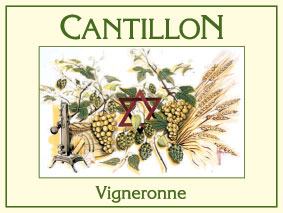יום שישי, אוקטובר 20, 2006
Havdalah beer?

Cantillon is one of the world's premier lambic brewers, which we had the pleasure of touring (tasting included!) when we were in Brussels in 2003. (Lambic is really neither lager nor ale, but a distinct and relatively rare category of beer that can be made only in certain parts of the Brussels region--mainly the Senne valley--as it is open-fermented and relies on local bacteria in the atmosphere only there.)
Of course, I know the blessing over the wine. But if there is a blessing over beer, I have not had the pleasure of learning it yet. The early Israelites' contact with beer might have been rather minimal, and the beer that they might have known would hardly be recognizable to us (no hops, for example). And they certainly would not have known anything like lambic. But beverages that meet the basic definition of beer are know to have existed in Babylonia and other ancient civilizations, including Egypt.
But the Vigneronne Cantillon is practically a wine, anyway. As the Cantillon website explains:
The lambic brewers weren't only established in the Senne valley, but also in the valley of the Yssche . This small river has its spring in the Forêt de Soignes and flows through villages like Hoeilaart, Overijse and Huldenberg. In this valley there used to live many brewers who made delicious lambic.
They didn't add cherries or raspberries [common flavorings for lambic] to their beer, but grapes which had been cultivated in greenhouses. By blending muscat grapes and lambic, the brewers and beer merchants produced the "druivenlambik" (grapes lambic). [...]
The name Vigneronne Cantillon was given in 1987. This name reminds us that, while it belongs to the beer patrimony, the spontaneous fermentation, the ageing in the barrels for several years and the addition of grapes make it a distant cousin of certain white wines.
I did not even notice till after we had finished the bottle what was on the label. It sure does look like a Star of David. Perfect, it is a Jewish lambic after all!
Well, no:
The six-pointed star on our label is an alchemist's symbol. It contains four elements, represented by triangles, of the brewing process. The fire is the symbol of the mashing tun, the earth of the cereals, the air of the yeasts, and the water is the fourth element. At this moment, only a brewer of traditional lambic may use this symbol.
Oh, and no, we did not extinguish a candle in the lambic.